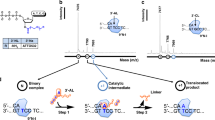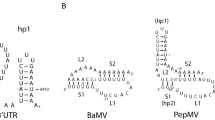Abstract
IT was recently reported that phosphodiesterase isolated from Micrococcus pyogenes var. aureus hydrolyses tobacco mosaic virus nucleic acid giving rise to di- and mono-nucleotides1,2. On the basis of its action on this acid and synthetic polymers, polycytidylic acid and polyuridylic acid, it was postulated that the enzyme first cleaves the large nucleic acid molecule into several polynucleotides, which are further broken down by stepwise cleavage of mononucleoside 3′-phosphates starting from one end, until they are reduced to the size of dinucleotides, which are resistant to further action of the enzyme. Thus the enzyme appears to have both endo- and exo-actions. From the amounts of dinucleotides present in the final digest of tobacco mosaic virus nucleic acid, one can calculate the number of intramolecular breaks that are produced in the acid by the endo-action of the enzyme, by assuming that the dinucleotides are at one end of the resultant polynucleotide fragment. In these calculations the data used for the purine and pyrimidine composition of tobacco mosaic virus nucleic acid are those published earlier3, and the molecular weight of nucleic acid was taken as 2 × 106 (ref. 4). From the calculations it appears that tobacco mosaic virus nucleic acid has been degraded to approximately 1,240 polynucleotide fragments, having an average weight of 1,600 or an average length of approximately 5 nucleotides.
This is a preview of subscription content, access via your institution
Access options
Subscribe to this journal
Receive 51 print issues and online access
$199.00 per year
only $3.90 per issue
Buy this article
- Purchase on Springer Link
- Instant access to full article PDF
Prices may be subject to local taxes which are calculated during checkout
Similar content being viewed by others
References
Reddi, K. K., Nature, 182, 1308 (1958).
Reddi, K. K., Biochim. Biophys. Acta, 36, 132 (1959).
Reddi, K. K., Biochim. Biophys. Acta, 23, 209 (1957).
Gierer, A., Nature, 179, 1297 (1957).
Reddi, K. K., Biochim. Biophys. Acta, 27, 1 (1958).
Wyatt, G. R., Biochem. J., 48, 584 (1951).
Author information
Authors and Affiliations
Rights and permissions
About this article
Cite this article
REDDI, K. Mode of Action of Micrococcal Phosphodiesterase. Nature 187, 74–75 (1960). https://doi.org/10.1038/187074a0
Issue Date:
DOI: https://doi.org/10.1038/187074a0
This article is cited by
-
Staphylococcal nuclease reviewed: A prototypic study in contemporary enzymology. I isolation; physical and enzymatic properties
Molecular and Cellular Biochemistry (1978)
Comments
By submitting a comment you agree to abide by our Terms and Community Guidelines. If you find something abusive or that does not comply with our terms or guidelines please flag it as inappropriate.



